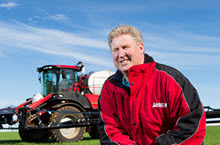Precision agriculture for pastures
30 March 2017
 Self-confessed data junkie Mark Branson, of Branson Farms, is applying technologies he refined when growing crops to pasture improvement.
Self-confessed data junkie Mark Branson, of Branson Farms, is applying technologies he refined when growing crops to pasture improvement.
The mixed farmer grows wheat, barley, faba beans and canola and runs a self-replacing, fine wool Merino flock on 1,800ha at Stockport, north of Adelaide, South Australia.
At MLA’s Red Meat Industry Digital Strategy Forum in Brisbane in 2016, he outlined how he is taking the soil diagnostic and yield assessment tools more commonly used by grain growers and applying them to his pasture management.
“My father sowed the seeds for this concept more than 35 years ago and taught me that soil type, fertility and yield can vary significantly in short distances,” Mark said.
“Just because it’s in the same paddock, doesn’t mean it’s the same throughout, and there is no point wasting money planting or applying something if it’s not going to do any good.”
Before computerised analysis tools, Mark made assessments with soil tests and by ‘eye’ and used that knowledge, combined with yield data from previous crops, to plan his sowing program.
Tools for today
Today, Mark uses the digital program SMS Advanced, which enables him to store multiple levels of information on paddocks, including maps of soil types, nutrient levels and pH, and to divide those paddocks into management zones that can be treated specifically to optimise performance.
That information is then transferred from the home computer to the tractor to guide seed and nutrient applications via GPS.
Mark said that by applying this mapping and analysis tool to cropping – by planting suitable varieties and applying correct nutrients – he has captured an extra $60/ha.
“This is partly a result of being able to increase production, but is mostly derived from savings on nutrient inputs (about $40/ha),” he said.
“Interestingly, the drop off of nutrient rates has also led to a slight increase in yields, due to the improvement of soil structure and the placement of nutrients where plants need them.”
Soil tests at Branson Farms are conducted annually on a rotational basis, so paddocks are routinely assessed about once every 10 years.
The property has a strong fertiliser history with phosphorus applied at maintenance levels only and legumes are used to improve soil nitrogen.
“Our soil types are mosaic and they can change very quickly from one type to another,” he said.
“I believe we increase our pasture growth by about a third by planting optimally, e.g. putting sub-clovers in acidic soils and medics on alkaline.
“We also waste far less seed.”
Maximising the benefit
Mark also believes pH mapping matched to GPS – undertaken in his case by a consultant – can have a considerable impact on profitability. He said pH maps enabled him to vary the rate of lime applied across paddocks, according to the degrees of acidity.
“They take some work to set up, but once you’ve got pH maps they are a powerful management and decision tool,” he said.
“Some of our red soils are becoming acidic so we need to be able to pinpoint those areas to improve their productivity and to control our liming and spreading costs.”
Sodic soils (high sodium soils) are treated with gypsum applied generally at high rates (5t/ha) determined by slump soil tests, which essentially measure soil stability when soil gets wet.
“We use the soil colour and texture, as well as this test, to see if the soil’s structure could be improved with the application of gypsum,” he said.
“In the past, we’ve found some areas have needed treatments of both gypsum and lime.”
Mark said they were trying to keep on top of the acid issue in red ‘soapy’ soils and areas requiring treatment were decreasing over time.
Making the most of digital technologies in pastures
According to Mark, the greatest value comes from:
- understanding the problem you are trying to fix
- having good data on paddock variability
- only using technology if it helps manage a challenge.
More Information:
Mark Branson
E: mark@bransonfarms.com.au
Watch Mark's presentation from the MLA Red Meat Industry Digital Strategy Forum


